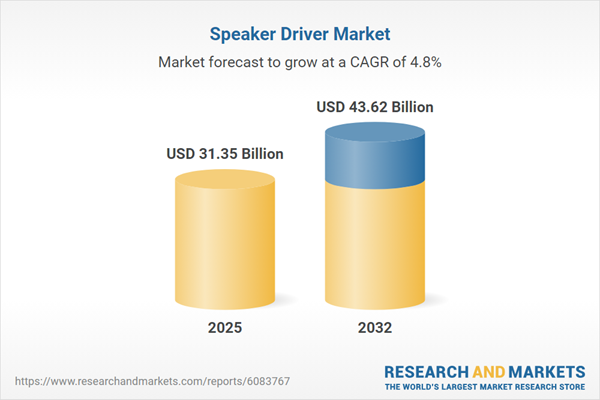Speak directly to the analyst to clarify any post sales queries you may have.
The speaker driver market is advancing rapidly on the strength of maturing audio technologies, transforming competitive strategies and product design for stakeholders across the value chain. As audio integration trends, new regulatory policies, and evolving end-user expectations converge, the landscape is redefining market opportunities and risks for senior decision-makers.
Speaker Driver Market Snapshot
The speaker driver market grew from USD 29.87 billion in 2024 to USD 31.35 billion in 2025. It is expected to continue its upward trajectory at a CAGR of 4.84%, reaching USD 43.62 billion by 2032. Increasing demand for immersive audio, miniaturized components, and smart connectivity are accelerating adoption in high-growth sectors such as automotive, consumer electronics, and professional audio. Regional dynamics shape differentiating opportunities, while competitive rivalry intensifies among leading OEM and component manufacturers as technology innovations accelerate.
Scope & Segmentation
This report delivers a comprehensive scope covering key market dimensions, technologies, and regions to inform product, investment, and partnership strategies for executives.
- Driver Types: Balanced armature, dynamic, electrostatic, and planar magnetic drivers for varied audio fidelity needs.
- Voice Coil Designs: Alloy aluminum, pure aluminum, copper clad aluminum, and pure copper alternatives to balance performance and cost-efficiency.
- Applications: Integration in automotive infotainment, consumer electronics, gaming peripherals, and professional audio solutions.
- Distribution Channels: Direct sales, distributor networks, and online sales platforms supporting diverse regional go-to-market strategies.
- Regional Focus: Americas, EMEA, and Asia-Pacific, including sub-segments in North America, Latin America, Europe, Middle East, Africa, and major Asia-Pacific economies.
- Technological Innovations: Advanced membrane materials, novel magnet structures, eco-friendly substrates, and embedded digital signal processing capabilities.
- Company Coverage: Leading profiles such as AAC Acoustic Technologies, GoerTek, Knowles Electronics LLLC, Harman International, Panasonic, PUI Audio, Yamaha, Bowers & Wilkins, KEF, and Dynaudio.
Key Takeaways for Decision-Makers
- Technological convergence is driving significant changes, with features like embedded digital signal processing and low-latency wireless codecs reshaping product integration and user experience.
- Shifting consumer demand for personalized listening environments and immersive audio experiences is accelerating modular driver design adoption across specialty and mainstream markets.
- Material science advancements are furthering sustainability initiatives, with lightweight, efficient components supporting growth in portable devices and automotive electronics.
- Regional regulatory policies and evolving environmental standards require manufacturers to optimize sourcing and production strategies to maintain compliance and mitigate risks.
- Distribution strategies are in flux, with online channels facilitating broader reach and rapid procurement, while traditional networks remain vital for commercial and OEM segments.
Impact of U.S. Tariff Measures on the Speaker Driver Market
New United States tariff measures introduced in 2025 have heightened input costs for critical raw materials used in speaker drivers and challenged established global supply chain models. Manufacturers are reevaluating procurement and localization strategies, often diversifying sourcing to manage import duties and mitigate added expenses. These shifts drive complexity in cost structures and competitive positioning, especially for firms dependent on international suppliers and export-centric business models. Enhanced agility and continued R&D investment are proving essential for companies adjusting to this evolving trade landscape.
Speaker Driver Market Methodology & Data Sources
The analysis is based on a robust mixed-methodology, drawing from systematic reviews of technical literature, patents, and regulatory reports. Extensive interviews with executives, engineering teams, and supply chain experts were conducted to validate findings and capture diverse industry perspectives. Data triangulation, regression analysis, and scenario modeling further ensure the accuracy and credibility of the report's insights, supported by peer review and methodological audits.
Why This Report Matters
- Enables senior leaders to identify emerging technology trends and align product strategies with market opportunities.
- Equips supply chain and R&D teams with actionable intelligence on regional challenges, competitive moves, and evolving compliance standards.
- Supports resource allocation and partnership decisions through deep segmentation and company profiling.
Conclusion
The speaker driver market is shaped by an interplay of innovation, regional dynamics, and regulatory change. Executives leveraging this analysis will be best positioned to seize growth opportunities, respond to new risks, and sustain leadership amid ongoing transformation in global audio technologies.
Table of Contents
3. Executive Summary
4. Market Overview
7. Cumulative Impact of Artificial Intelligence 2025
Companies Mentioned
The companies profiled in this Speaker Driver market report include:- AAC Acoustic Technologies (Shenzhen) Co., Ltd
- GoerTek
- Knowles Electronics LLLC
- Harman International by Samsung Electronics Co., Ltd.
- Panasonic Corporation
- PUI Audio, Inc.
- Yamaha Corporation
- Bowers & Wilkins Group Ltd.
- KEF International by GP Acoustics International Limited
- Dynaudio A/S
Table Information
| Report Attribute | Details |
|---|---|
| No. of Pages | 188 |
| Published | November 2025 |
| Forecast Period | 2025 - 2032 |
| Estimated Market Value ( USD | $ 31.35 Billion |
| Forecasted Market Value ( USD | $ 43.62 Billion |
| Compound Annual Growth Rate | 4.8% |
| Regions Covered | Global |
| No. of Companies Mentioned | 11 |









